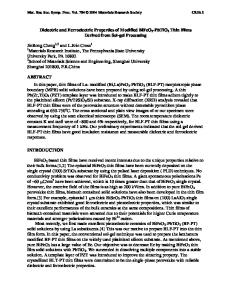Dielectric and Piezoelectric Properties of Gd-modified (1-x) BiFeO 3 -xPbTiO 3 Ceramics with a Morphotropic Phase Bounda
- PDF / 731,908 Bytes
- 6 Pages / 612 x 792 pts (letter) Page_size
- 33 Downloads / 358 Views
Dielectric and Piezoelectric Properties of Gd-modified (1-x) BiFeO3 -xPbTiO3 Ceramics with a Morphotropic Phase Boundary Dalei Wang1 , Shundong Bu1 , Guoxi Jin1 , RuiDai1 , Dengren Jin1 and Jinrong Cheng1 * School of materials science and engineering, Shanghai University, Shanghai 200072, P.R.China *corresponding author: [email protected] ABSTRACT (1-x)(Bi0.8 Gd0.2 )FeO3-xPbTiO 3 (BGF-PT) solid solutions ceramics of x=0.55,0.50,0.4975, 0.49 and 0.45 were prepared by the mixed oxide method. Gd3+ of 20 at% was introduced into the Bi3+ site to improve the dielectric and piezoelectric properties of BFPT without causing the significant reduction of Curie temperature (Tc ). X-ray diffraction analysis shows a transformation from the tetragonal (T) to rhombohedral (R) phase with the increase of BGF content. The morphotropic phase boundary was determined by measuring the dielectric and piezoelectric properties of BGF-PT within a wide composition range. BGF-PT for x=0.4975 shows the coexistence of T and R phases with the dielectric constant and loss of about 895 and 0.031 respectively at the frequency of 10 2 Hz. INTRODUCTION The piezoelectric effect has been used in several technological applications for many years [1-3]. Perovskite Pb(Zr,Ti)O 3 PZT piezoelectric ceramics have been widely used in transducers and actuator devices, such as sonar, transformer and energy recovery equipment [4-5]. Advantages of PZT based materials are temperature insensitive in the vicinity of morphotropic phase boundary (MPB) between ferroelectric rhombohedral and tetragonal phases, and the coexistence of both phases near the MPB results in enhancements of the dielectric and piezoelectric properties. However, lead free or low- lead-content materials are of current interest, as potential environmentally friendly materials. Bismuth containing perovskites were first reported in 1962 by Buhrer[6]. Unfortunately, the insulation resistance of these BFO based materials have not yet been raised sufficiently, while the perovskite structure of these crystalline solutions has been shown stable. BiFeO 3 –PbTiO 3 (BF-PT) has been reported to be a continuous solid solution across its entire composition range with a rhombohedral-tetragonal morphotropic phase boundary [7,8]. The insulation and piezoelectric properties of BF-PT have been significantly enhanced with substituting Bi3+ by La3+ ions. Unfortunately, La substitutions significantly decrease the Curie temperature of BF-PT [9]. Shi et al.[10] have reported that introduction of 20 at% Gd in BF-PT could increase its dielectric properties without causing the Tc to decrease significantly. The ionic radii of Gd3+ is almost same as that of Bi3+. In this investigation, Gd3+ ions of 20 at% were incorporated into the Bi3+ sites, solid solutions of (1-x) (Bi0.8 Gd0.2 )FeO3- xPbTiO 3 (BGF-PT) were prepared for different PT contents. The crystalline structural, dielectric and piezoelectric properties of BGF-PT were investigated systematically.
EXPERIMENTAL PROCEDURE Solid solutions of (1- x)(Bi0.8 Gd0.2 )FeO3-xPb
Data Loading...











